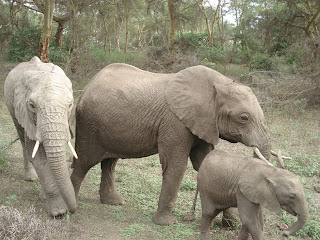I started my tour by taking a bus from Arusha, Tanzania down to the village of Kolo. What should have been a 6 hour drive on a mostly dirt road, turned into more than 10 hours because the bus broke down. Eventually my guide and I made it to Kolo where we had to postpone our hike to the ancient rock sites until the morning (it was too dark). When we did go to the rock paintings (which were pretty neat when we finally got there, though not as impressive as I had thought they might be) my guide got lost about four or five times. His English was not to great so it was hard for him to communicate to me what the problem was (though he kept saying "The problem is...").
Because we got lost, we missed our bus connection to the next town (Kelema). Though it sounds sketchy, the guide managed to get us a ride on a truck. It was actually a nice experience.
We got in fairly late (and were delayed due to security issues having to be sorted out for where I was staying (there was no lock or door where I was to be sleeping, even though I was promised both). We weren't able to do much that night, so we had dinner and went to bed. I got to stay in a house with no electricity or running water, but it was survivable.
The next day we went for a walk to a water project. Basically it was a hole in the ground, but in the future it would be fitted with a building and a pump for the community. Unfortunately, my guide didn't know much about it and couldn't really answer my questions (and even if he did know about it, his llack of English might have prevented him from answering). We also visited some teachers and walked around a lot that day.
Afterwards we caught a bus to another town (Kondoa) where I was put up in a hotel and given "time to rest" for the whole afternoon.
The next day I took a tour of the town which included seeing a natural spring, visiting an orphanage (where the children were extremely well cared for), and touring a market. The next morning I took a six hour busride back to Arusha.
As you may tell from my writing, I was not completely pleased with this tour, and will dedicate a whole post to that (mostly as a warning for anyone wanting to do a cultural tour). However, I want this one to be about what I did (since when I actually did things it was somewhat interesting.
Anyway, here are some pictures of the tour: 1) The bus was stopped like this for hours while we waited for a bolt to be driven from the nearest town, 2) A "river" near Kolo - it has been very dry recently, 3 and 4) some of the rock paintings near Kolo, 5) A family near the water project. As I arrived, they were all working the soil (I don't know the exact word). Even the older man and women were doing this physical labour. 6) What I was told was a Christmas Tree. Um... 7) These trees were grown by a women's cooperative in Kondoa and sold to peoplel. There were a large number of trees, including many fruit trees. 8) The very friendly and cheerful children at the orphanage.























































